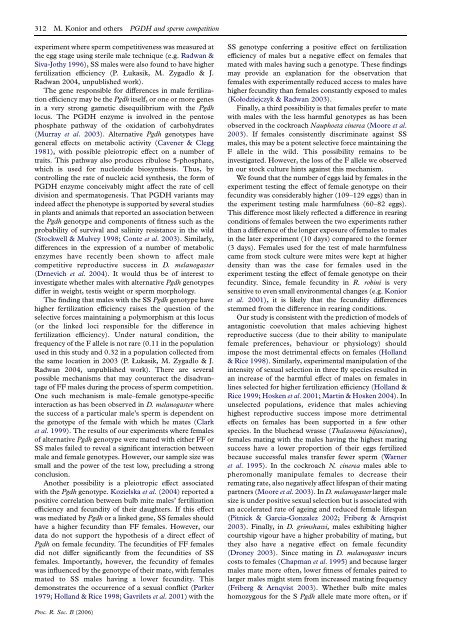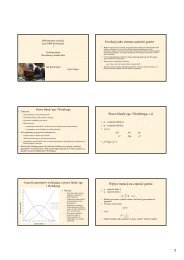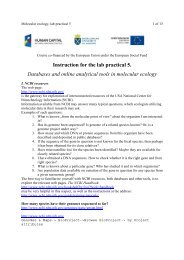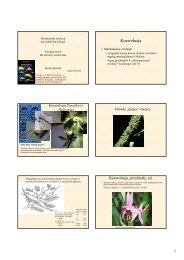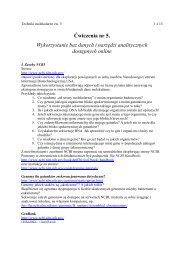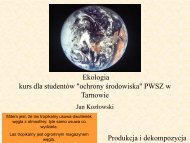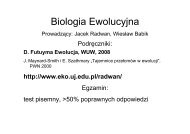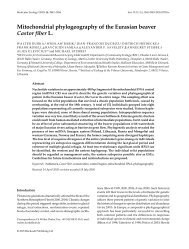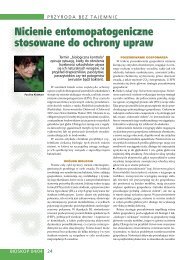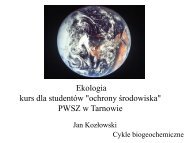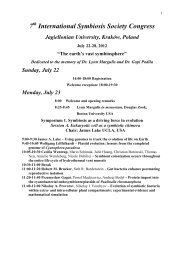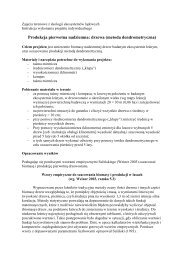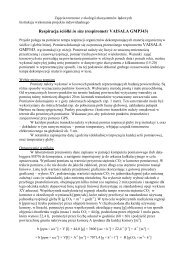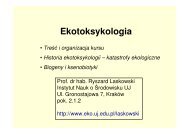Strong association between a single gene and fertilization efficiency ...
Strong association between a single gene and fertilization efficiency ...
Strong association between a single gene and fertilization efficiency ...
You also want an ePaper? Increase the reach of your titles
YUMPU automatically turns print PDFs into web optimized ePapers that Google loves.
312 M. Konior <strong>and</strong> others PGDH <strong>and</strong> sperm competition<br />
experiment where sperm competitiveness was measured at<br />
the egg stage using sterile male technique (e.g. Radwan &<br />
Siva-Jothy 1996), SS males were also found to have higher<br />
<strong>fertilization</strong> <strong>efficiency</strong> (P. Łukasik, M. Zygadlo & J.<br />
Radwan 2004, unpublished work).<br />
The <strong>gene</strong> responsible for differences in male <strong>fertilization</strong><br />
<strong>efficiency</strong> may be the Pgdh itself, or one or more <strong>gene</strong>s<br />
in a very strong gametic disequilibrium with the Pgdh<br />
locus. The PGDH enzyme is involved in the pentose<br />
phosphate pathway of the oxidation of carbohydrates<br />
(Murray et al. 2003). Alternative Pgdh genotypes have<br />
<strong>gene</strong>ral effects on metabolic activity (Cavener & Clegg<br />
1981), with possible pleiotropic effect on a number of<br />
traits. This pathway also produces ribulose 5-phosphate,<br />
which is used for nucleotide biosynthesis. Thus, by<br />
controlling the rate of nucleic acid synthesis, the form of<br />
PGDH enzyme conceivably might affect the rate of cell<br />
division <strong>and</strong> spermato<strong>gene</strong>sis. That PGDH variants may<br />
indeed affect the phenotype is supported by several studies<br />
in plants <strong>and</strong> animals that reported an <strong>association</strong> <strong>between</strong><br />
the Pgdh genotype <strong>and</strong> components of fitness such as the<br />
probability of survival <strong>and</strong> salinity resistance in the wild<br />
(Stockwell & Mulvey 1998; Conte et al. 2003). Similarly,<br />
differences in the expression of a number of metabolic<br />
enzymes have recently been shown to affect male<br />
competitive reproductive success in D. melanogaster<br />
(Drnevich et al. 2004). It would thus be of interest to<br />
investigate whether males with alternative Pgdh genotypes<br />
differ in weight, testis weight or sperm morphology.<br />
The finding that males with the SS Pgdh genotype have<br />
higher <strong>fertilization</strong> <strong>efficiency</strong> raises the question of the<br />
selective forces maintaining a polymorphism at this locus<br />
(or the linked loci responsible for the difference in<br />
<strong>fertilization</strong> <strong>efficiency</strong>). Under natural condition, the<br />
frequency of the F allele is not rare (0.11 in the population<br />
used in this study <strong>and</strong> 0.32 in a population collected from<br />
the same location in 2003 (P. Łukasik, M. Zygadlo & J.<br />
Radwan 2004, unpublished work). There are several<br />
possible mechanisms that may counteract the disadvantage<br />
of FF males during the process of sperm competition.<br />
One such mechanism is male–female genotype-specific<br />
interaction as has been observed in D. melanogaster where<br />
the success of a particular male’s sperm is dependent on<br />
the genotype of the female with which he mates (Clark<br />
et al. 1999). The results of our experiments where females<br />
of alternative Pgdh genotype were mated with either FF or<br />
SS males failed to reveal a significant interaction <strong>between</strong><br />
male <strong>and</strong> female genotypes. However, our sample size was<br />
small <strong>and</strong> the power of the test low, precluding a strong<br />
conclusion.<br />
Another possibility is a pleiotropic effect associated<br />
with the Pgdh genotype. Kozielska et al. (2004) reported a<br />
positive correlation <strong>between</strong> bulb mite males’ <strong>fertilization</strong><br />
<strong>efficiency</strong> <strong>and</strong> fecundity of their daughters. If this effect<br />
was mediated by Pgdh or a linked <strong>gene</strong>, SS females should<br />
have a higher fecundity than FF females. However, our<br />
data do not support the hypothesis of a direct effect of<br />
Pgdh on female fecundity. The fecundities of FF females<br />
did not differ significantly from the fecundities of SS<br />
females. Importantly, however, the fecundity of females<br />
was influenced by the genotype of their mate, with females<br />
mated to SS males having a lower fecundity. This<br />
demonstrates the occurrence of a sexual conflict (Parker<br />
1979; Holl<strong>and</strong> & Rice 1998; Gavrilets et al. 2001) with the<br />
SS genotype conferring a positive effect on <strong>fertilization</strong><br />
<strong>efficiency</strong> of males but a negative effect on females that<br />
mated with males having such a genotype. These findings<br />
may provide an explanation for the observation that<br />
females with experimentally reduced access to males have<br />
higher fecundity than females constantly exposed to males<br />
(Kołodziejczyk & Radwan 2003).<br />
Finally, a third possibility is that females prefer to mate<br />
with males with the less harmful genotypes as has been<br />
observed in the cockroach Nauphoeta cinerea (Moore et al.<br />
2003). If females consistently discriminate against SS<br />
males, this may be a potent selective force maintaining the<br />
F allele in the wild. This possibility remains to be<br />
investigated. However, the loss of the F allele we observed<br />
in our stock culture hints against this mechanism.<br />
We found that the number of eggs laid by females in the<br />
experiment testing the effect of female genotype on their<br />
fecundity was considerably higher (109–129 eggs) than in<br />
the experiment testing male harmfulness (60–82 eggs).<br />
This difference most likely reflected a difference in rearing<br />
conditions of females <strong>between</strong> the two experiments rather<br />
than a difference of the longer exposure of females to males<br />
in the later experiment (10 days) compared to the former<br />
(3 days). Females used for the test of male harmfulness<br />
came from stock culture were mites were kept at higher<br />
density than was the case for females used in the<br />
experiment testing the effect of female genotype on their<br />
fecundity. Since, female fecundity in R. robini is very<br />
sensitive to even small environmental changes (e.g. Konior<br />
et al. 2001), it is likely that the fecundity differences<br />
stemmed from the difference in rearing conditions.<br />
Our study is consistent with the prediction of models of<br />
antagonistic coevolution that males achieving highest<br />
reproductive success (due to their ability to manipulate<br />
female preferences, behaviour or physiology) should<br />
impose the most detrimental effects on females (Holl<strong>and</strong><br />
& Rice 1998). Similarly, experimental manipulation of the<br />
intensity of sexual selection in three fly species resulted in<br />
an increase of the harmful effect of males on females in<br />
lines selected for higher <strong>fertilization</strong> <strong>efficiency</strong> (Holl<strong>and</strong> &<br />
Rice 1999; Hosken et al. 2001; Martin & Hosken 2004). In<br />
unselected populations, evidence that males achieving<br />
highest reproductive success impose more detrimental<br />
effects on females has been supported in a few other<br />
species. In the bluehead wrasse (Thalassoma bifasciatum),<br />
females mating with the males having the highest mating<br />
success have a lower proportion of their eggs fertilized<br />
because successful males transfer fewer sperm (Warner<br />
et al. 1995). In the cockroach N. cinerea males able to<br />
pheromonally manipulate females to decrease their<br />
remating rate, also negatively affect lifespan of their mating<br />
partners (Moore et al. 2003). In D. melanogaster larger male<br />
size is under positive sexual selection but is associated with<br />
an accelerated rate of ageing <strong>and</strong> reduced female lifespan<br />
(Pitnick & Garcia-Gonzalez 2002; Friberg & Arnqvist<br />
2003). Finally, in D. grimshawi, males exhibiting higher<br />
courtship vigour have a higher probability of mating, but<br />
they also have a negative effect on female fecundity<br />
(Droney 2003). Since mating in D. melanogaster incurs<br />
costs to females (Chapman et al. 1995) <strong>and</strong> because larger<br />
males mate more often, lower fitness of females paired to<br />
larger males might stem from increased mating frequency<br />
(Friberg & Arnqvist 2003). Whether bulb mite males<br />
homozygous for the S Pgdh allele mate more often, or if<br />
Proc. R. Soc. B (2006)


